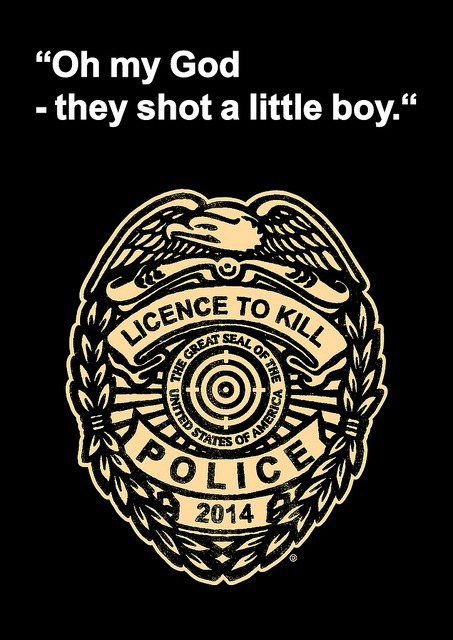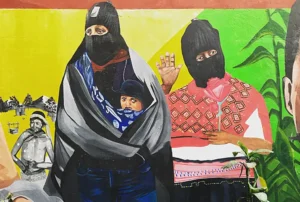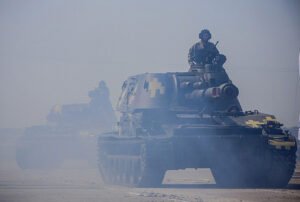
October 10, 2015; Cleveland Plain Dealer (Northeast Ohio Media Group)
The special investigator hired by the Cuyahoga County Prosecutor’s Office has issued an eight-page report exonerating Cleveland police officer Timothy Loehmann for having killed 12-year-old Tamir Rice at a local rec center. A retired FBI agent and a professor of criminal justice at Northern Virginia Community College, Kimberly Crawford declared Loehmann’s actions reasonable. Crawford’s analysis touched on these points:
- Loehmann and his partner, Officer Frank Garmback, had been called to the rec center because of reports of a man with a gun.
- When they encountered Rice, the officers reported that Rice reached for his waistband, that is, “in the directions of a ‘high risk area’—an area where a weapon may be concealed—such as inside a jacket, towards the waistband of pants or under the seat of a car, well-trained officers will immediately identify this as a serious threat.”
- The fact that Rice was carrying a toy “airsoft” gun “is not relevant to a constitutional review of officer Loehmann’s actions” in that Loehmann “had no information to suggest that the weapon was anything but a real handgun.”
- Rice’s age was also not relevant to the constitutionality of Loehmann’s actions, and “even if his age was known at the time of the incident, [Rice] was perfectly capable of inflicting death or serious physical injury.”
Crawford’s blunt assessment is based on information that outsiders like NPQ cannot corroborate nor disprove, but other information has come to light that raises information about Crawford’s potential biases. The attorney for the Rice family has disclosed that Crawford’s opinion in a past case involving police use of force was rejected by the U.S. Department of Justice for being “overly protective of law enforcement” and “too far to exonerate the use of force.” Specifically, the issue in question was an opinion co-authored by Crawford and another FBI agent to review two rifle shots fired by an FBI hostage team officer named Lon Horiuchi at the 1992 Ruby Ridge confrontation in Idaho between the FBI and the right-wing survivalist Randy Weaver and his family. Horiuchi’s first shot seems to have been justified, but there was significant debate as to whether his second shot was. Crawford and her colleague wrote in their legal memorandum that both of Horiuchi’s shots were “reasonable under constitutional standards,” that Horiuchi “ha(d) a reasonable basis for believing that the two armed, male suspects at whom he fired his rifle met the constitutional criteria for dangerousness,” and that “no safe alternatives were available.” Moreover, without the second shot, “a demonstrably dangerous (and armed) person (might have been able) to regain a position of cover and concealment.”
Contrary to the Crawford analysis, the Justice Department task force reviewing Ruby Ridge explicitly rejected the defense of the second shot, using language pertinent to the Tamir Rice investigation:
“The use of deadly force…requires that the officer have ‘probable cause to believe’ that the person ‘poses a threat of serious physical harm.’…(T)he immediate threat requirement is reiterated in the Supreme Court in its conclusion that the ‘proper application’ of the Fourth Amendment to the use of deadly force requires careful attention to a number of factors, which include not only ‘the severity of the crime at issue,’ but also ‘whether the subject poses an immediate threat.’”
The FBI task force report continued:
Sign up for our free newsletters
Subscribe to NPQ's newsletters to have our top stories delivered directly to your inbox.
By signing up, you agree to our privacy policy and terms of use, and to receive messages from NPQ and our partners.
“We believe that in examining the ‘totality of the circumstances’ surrounding the first shot taken by the sniper/observer, the shot met the constitutional standard of ‘objective reasonableness.’ Applying the same analysis, we believe, that the second shot did not meet that standard. Although we did not believe that the existence of an immediate threat is a precondition for the legitimate use of deadly force, we do believe that its presence or absence is important. In this case, we conclude that the [FBI] sniper/observer did not have a reasonable fear of an immediate threat to the safety of law enforcement personnel or others when he fired the second shot.”
Interestingly, the DOJ task force concluded that the second shot that Crawford and her co-author exonerated “violated the Constitution.” Why would that conclusion be particularly relevant in the Rice case? Because of this first paragraph in Crawford’s Cleveland report:
“The sole purpose of this report is to review the use of deadly force by CPD Officer Timothy Loehmann from the perspective of the United States Constitution. No opinion is rendered with respect to Ohio state criminal law or CPD policy.”
That’s the precise point that seems to have been underplayed in the press coverage and missed in the activists’ critique. Representatives of Hands Up United and Color of Change both denounced the Crawford report (as well as another report from an expert hired by the Prosecutor’s office) as having been meant to deny the Rice family its day in court. A statement released by Hands Up United took Crawford to task, not for having issued an analysis at Ruby Ridge that the Justice Department dismissed as wrong, but for having been used by the FBI in 2003 to counsel agents on the proper use of Miranda rights. NPQ actually found two documents, written by Crawford for the FBI Law Enforcement Bulletin, dating from 2003 and 1997 and directing FBI agents to accurately follow the rules on Miranda rights else agents jeopardize cases and subject themselves to prosecution.
Activists cannot condemn any and all experts who have worked for or advised the FBI, the police, or other law enforcement bodies, else they eliminate just about all possibilities of experts they recruit as well. Rather, they have to look at the specifics of the expert, his or her track record and judgments, rather than making broad-brush arguments like those of Hands Up United. The problem with Crawford as a Cleveland expert is that the Justice Department declared her wrong on constitutional grounds in a case of excessive use of force, and that is exactly what she was being asked to review in Cleveland in the Tamir Rice killing.
The end result is that Crawford may well have been an inappropriate expert to weigh in on excessive police force in the killing of Tamir Rice, but because of the DOJ’s explicit rejection of her mistaken constitutional analysis in Ruby Ridge, not because she happened to have an employment background with the FBI and advised the FBI on Miranda laws.—Rick Cohen












